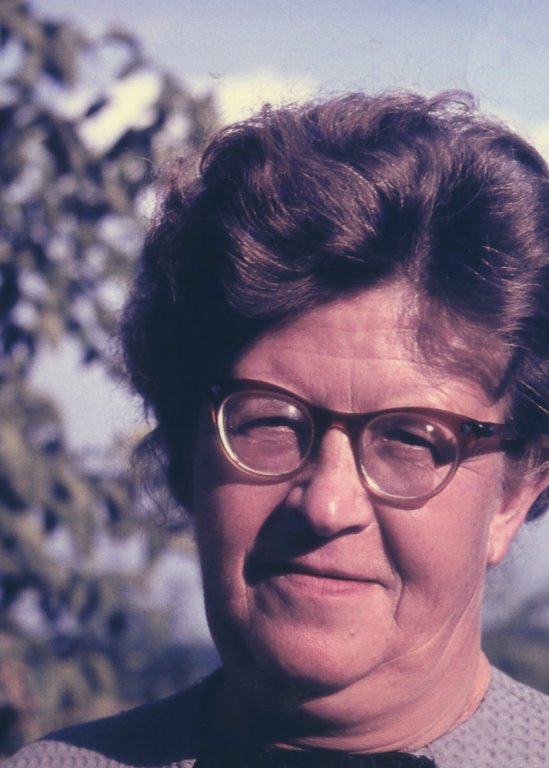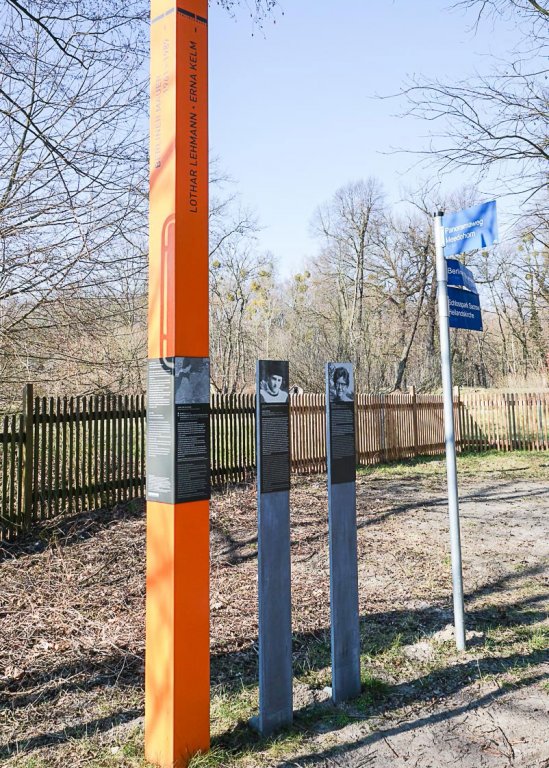born on July 21, 1908
drowned on June 11, 1962
in the Havel River
on the outer ring between Sacrow (Potsdam city district) and Berlin-Zehlendorf
Kelm, Erna
In the early morning hours of July 11, 1962, a fisherman on the West Berlin side of the Havel River noticed the body of a woman floating in the water. He notified the police, who brought the body to land by boat a short time later. At this spot south of Nikolskoe, the border to East Germany ran through the middle of the river. The West Berlin district of Zehlendorf was situated on the one side; Sacrow, which belonged to the East German district of Potsdam, on the other. It was soon learned that the dead woman came from Sacrow. Her East German identification card, hidden in her sock, identified her as Erna Kelm from Sacrow, 53 years old. She was born on July 21, 1908 in Frankfurt (Oder). Everything suggested that she had tried to swim across the Havel to West Berlin. She was carrying other documents in a plastic bag on her body and was also wearing a life jacket under her clothes. [21]
The West Berlin investigation came to the following conclusions: „Because Frau Kelm was wearing a life jacket under her clothes it has been determined that she was attempting to flee to West Berlin by swimming across the river. According to the autopsy report, the cause of death was drowning. Upon the request of her living kin in Potsdam, her body was sent there." [22]
There was no trace of the body after it was transported to Potsdam. For a long time, it was not known where she was buried. [23] Even the West Berlin investigation, which documented the retrieval of the body from the water, was closed shortly thereafter and the file was sent to the Central Registry Office in Salzgitter. When the case was re-opened 30 years later, the original investigation findings were confirmed. [24]
Erna Kelm, who had last worked as the director of a special care facility, had lived in the West before the Wall was built. She moved from Potsdam to Lübeck in August 1947 without bothering to obtain the necessary permit issued by the occupying powers at that time. She worked as a nurse in Lübeck. In March 1948 she moved to West Berlin, where she had a position as nurse’s assistant in a children’s home for refugees. Because she often left West Berlin to visit her children in Potsdam, she was, according to police data, „suspected of engaging in intelligence activities," but this accusation remained unconfirmed. [25] It did, however, lead to her being interrogated in November 1953 after which she moved back to Potsdam because, in her own words, she missed her children.
Besides the files in the Central Registry Office in Salzgitter, the fate of Erna Kelm is otherwise only documented by a few newspaper reports. On June 13, 1962, the West Berlin newspaper „Tagesspiegel" reported on numerous incidents that had occurred at the Berlin Wall over the 1962 Whitsun holidays. One of the incidents involved the body of a woman retrieved from the lower Havel on Whitsum Monday, who was believed to have drowned while trying to flee. [26] The main focus of the report, however, was on the general concern over the rising tensions in Berlin. The Warsaw Pact members had submitted a statement over the holiday weekend announcing their plan to sign a separate peace treaty with East Germany if American-Soviet talks were not able to „normalize" the situation in West Berlin and remove the „occupying regime." The Soviet Union even sent a note of protest to the three western Allies, strongly criticizing the involvement of West Berlin police in border incidents at the Wall. [27] The mayor of West Berlin, Willy Brandt, used strong words to firmly dismiss the Soviet protest. „We will never be able to accept the Wall as something human or just," he declared. „As long as shots are fired at the Wall, as long as Germans who want to go from one side of the city to the other are called criminals and killed, it will not be possible to expand trade." [28]
On the first anniversary of the Berlin Wall, the Federal Ministry of All-German Affairs published a brochure taking stock of the unconstitutional crimes that occurred at the Wall. The document also mentioned Erna Kelm’s fatal escape attempt, which led to her name being added to the official lists of registered fatal victims. [29] In this way the memory of the 53-year-old woman who drowned at the border to West Berlin was preserved. [30]
Christine Brecht
The West Berlin investigation came to the following conclusions: „Because Frau Kelm was wearing a life jacket under her clothes it has been determined that she was attempting to flee to West Berlin by swimming across the river. According to the autopsy report, the cause of death was drowning. Upon the request of her living kin in Potsdam, her body was sent there." [22]
There was no trace of the body after it was transported to Potsdam. For a long time, it was not known where she was buried. [23] Even the West Berlin investigation, which documented the retrieval of the body from the water, was closed shortly thereafter and the file was sent to the Central Registry Office in Salzgitter. When the case was re-opened 30 years later, the original investigation findings were confirmed. [24]
Erna Kelm, who had last worked as the director of a special care facility, had lived in the West before the Wall was built. She moved from Potsdam to Lübeck in August 1947 without bothering to obtain the necessary permit issued by the occupying powers at that time. She worked as a nurse in Lübeck. In March 1948 she moved to West Berlin, where she had a position as nurse’s assistant in a children’s home for refugees. Because she often left West Berlin to visit her children in Potsdam, she was, according to police data, „suspected of engaging in intelligence activities," but this accusation remained unconfirmed. [25] It did, however, lead to her being interrogated in November 1953 after which she moved back to Potsdam because, in her own words, she missed her children.
Besides the files in the Central Registry Office in Salzgitter, the fate of Erna Kelm is otherwise only documented by a few newspaper reports. On June 13, 1962, the West Berlin newspaper „Tagesspiegel" reported on numerous incidents that had occurred at the Berlin Wall over the 1962 Whitsun holidays. One of the incidents involved the body of a woman retrieved from the lower Havel on Whitsum Monday, who was believed to have drowned while trying to flee. [26] The main focus of the report, however, was on the general concern over the rising tensions in Berlin. The Warsaw Pact members had submitted a statement over the holiday weekend announcing their plan to sign a separate peace treaty with East Germany if American-Soviet talks were not able to „normalize" the situation in West Berlin and remove the „occupying regime." The Soviet Union even sent a note of protest to the three western Allies, strongly criticizing the involvement of West Berlin police in border incidents at the Wall. [27] The mayor of West Berlin, Willy Brandt, used strong words to firmly dismiss the Soviet protest. „We will never be able to accept the Wall as something human or just," he declared. „As long as shots are fired at the Wall, as long as Germans who want to go from one side of the city to the other are called criminals and killed, it will not be possible to expand trade." [28]
On the first anniversary of the Berlin Wall, the Federal Ministry of All-German Affairs published a brochure taking stock of the unconstitutional crimes that occurred at the Wall. The document also mentioned Erna Kelm’s fatal escape attempt, which led to her name being added to the official lists of registered fatal victims. [29] In this way the memory of the 53-year-old woman who drowned at the border to West Berlin was preserved. [30]
Christine Brecht


